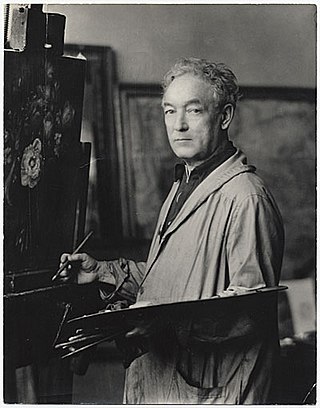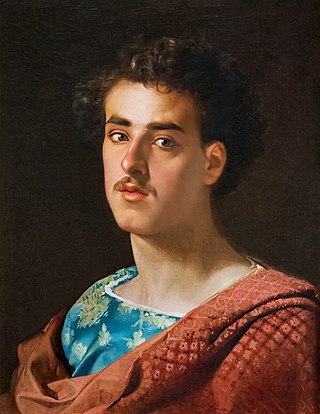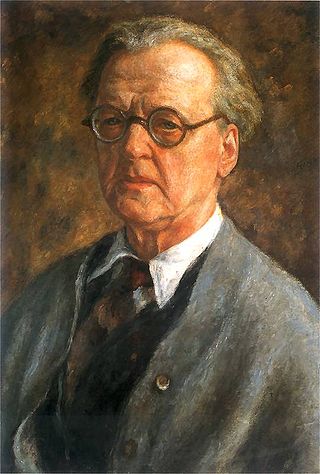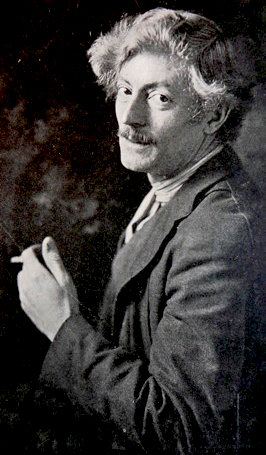
Impressionism was a 19th-century art movement characterized by relatively small, thin, yet visible brush strokes, open composition, emphasis on accurate depiction of light in its changing qualities, ordinary subject matter, unusual visual angles, and inclusion of movement as a crucial element of human perception and experience. Impressionism originated with a group of Paris-based artists whose independent exhibitions brought them to prominence during the 1870s and 1880s.

The Ten American Painters was an artists' group formed in 1898 to exhibit their work as a unified group. John Henry Twachtman, J. Alden Weir, and Childe Hassam were the driving forces behind the organization. Dissatisfied with the conservatism of the American art establishment, the three artists recruited seven others from Boston, New York City, and elsewhere on the East Coast, with the intention of creating an exhibition society that valued their view of originality, imagination, and exhibition quality. The Ten achieved popular and critical success, and lasted two decades before dissolving.

William James Glackens was an American realist painter and one of the founders of the Ashcan School, which rejected the formal boundaries of artistic beauty laid-down by the conservative National Academy of Design. He is also known for his work in helping Albert C. Barnes to acquire the European paintings that form the nucleus of the famed Barnes Foundation in Philadelphia. His dark-hued, vibrantly painted street scenes and depictions of daily life in pre-WW I New York and Paris first established his reputation as a major artist. His later work was brighter in tone and showed the strong influence of Renoir. During much of his career as a painter, Glackens also worked as an illustrator for newspapers and magazines in Philadelphia and New York City.

Marià Josep Maria Bernat Fortuny i Marsal, known more simply as Marià Fortuny or Mariano Fortuny, was the leading Spanish painter of his day, with an international reputation. His brief career encompassed works on a variety of subjects common in the art of the period, including the Romantic fascination with Orientalist themes, historicist genre painting, military painting of Spanish colonial expansion, as well as a prescient loosening of brush-stroke and color.

Frank Weston Benson, frequently referred to as Frank W. Benson, was an American artist from Salem, Massachusetts known for his Realistic portraits, American Impressionist paintings, watercolors and etchings. He began his career painting portraits of distinguished families and murals for the Library of Congress. Some of his best known paintings depict his daughters outdoors at Benson's summer home, Wooster Farm, on the island of North Haven, Maine. He also produced numerous oil, wash and watercolor paintings and etchings of wildfowl and landscapes.

Xavier Timoteo Martínez was a California artist active in the late 19th and early 20th century. He was a well-known bohemian figure in San Francisco, the East Bay, and the Monterey Peninsula and one of the co-founders of two California artists' organizations and an art gallery. He painted in a tonalist style and also produced monotypes, etchings, and silverpoint.

Józef Pankiewicz was a Polish impressionist painter, graphic artist and teacher who spent much of his career in France.

Paul Durand-Ruel was a French art dealer associated with the Impressionists and the Barbizon School. Being the first to support artists such as Claude Monet, Camille Pissarro, and Pierre-Auguste Renoir, he is known for his innovations in modernizing art markets, and is generally considered to be the most important art dealer of the 19th century. An ambitious entrepreneur, Durand-Ruel cultivated international interest in French artists by establishing art galleries and exhibitions in London, New York, Berlin, Brussels, among other places. Additionally, he played a role in the decentralization of art markets in France, which prior to the mid-19th century was monopolized by the Salon system.

Classical Realism is an artistic movement in the late-20th and early 21st century in which drawing and painting place a high value upon skill and beauty, combining elements of 19th-century neoclassicism and realism.
Frederico Aguilar Alcuaz was a Filipino painter who exhibited extensively Internationally and whose work earned him recognition both in the Philippines and abroad.
The Fine Art Trade Guild is an organisation representing the fine art and framing industry. Based in London, the Guild operates primarily in the United Kingdom and Ireland, also in a smaller capacity in New Zealand.

The Boston School was a group of Boston-based painters active in the first three decades of the twentieth century. Often classified as American Impressionists, they had their own regional style, combining the painterliness of Impressionism with a more conservative approach to figure painting and a marked respect for the traditions of Western art history. Their preferred subject matter was genteel: portraits, picturesque landscapes, and young women posing in well-appointed interiors. Major influences included John Singer Sargent, Claude Monet, and Jan Vermeer. Key figures in the Boston School were Edmund C. Tarbell, Frank Weston Benson, and William McGregor Paxton, all of whom trained in Paris at the Académie Julian and later taught at the School of the Museum of Fine Arts. Their influence can still be seen in the work of some contemporary Boston-area artists.

Dawson Dawson-Watson (1864–1939) was a British-born Impressionist painter who became famous in 1927 for winning the largest cash prize in American art, the Texas Wildflower Competitive Exhibition. He was one of the first members of the famous Impressionist colony in Giverny, France and was a prominent teacher in Hartford, Connecticut, St. Louis, Missouri and San Antonio, Texas.

Ethel Carrick, later Ethel Carrick Fox was an English Impressionist and Post-Impressionist painter. Much of her career was spent in France and in Australia, where she was associated with the movement known as the Heidelberg School.
François Gall was a Hungarian-French modern impressionist painter.

Darío de Regoyos y Valdés was a Spanish painter. He was notable for contributing to "the renewal of modern Spanish painting". A student of Carlos de Haes at the Real Academia de Bellas Artes de San Fernando in 1878, he later studied at the Académie Royale des Beaux-Arts in Brussels. He traveled extensively in the 1880s, accompanied by his friend, the painter Adolfo Guiard. He was a member of the art group L'Essor and a founding member of Les XX with the Belgian avant-garde scene. During these experiences he gained a significant influence from Impressionist and Neo-Impressionist painters.

The Grafton Galleries, often referred to as the Grafton Gallery, was an art gallery in Mayfair, London. The French art dealer Paul Durand-Ruel showed the first major exhibition in Britain of Impressionist paintings there in 1905. Roger Fry's two famous exhibitions of Post-Impressionist works in 1910 and 1912 were both held at the gallery.

Eliseu Meifrèn i Roig was a Spanish Impressionist painter.

Enric Galwey i Garcia or, in Spanish, Enrique Galwey y García was a Spanish painter, associated with the Olot school of landscape painting.
Jaume Muxart was a Catalan painter. He was part of the Grup Taüll of avant-garde artists.
















